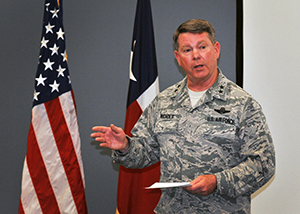Texas TAG encourages ANG leaders to build partnerships
Story by: 2nd Lt. Phil Fountain
Posted: October 7, 2016
 Maj. Gen. John F. Nichols, the adjutant general of Texas, addresses members of the Air National Guard Strategic Planning System Central Region during a meeting at Naval Air Station Fort Worth Joint Reserve Base, Texas, April 4, 2016. Nichols, a gubernatorial appointee, is the senior National Guard officer in Texas. (U.S. Air National Guard photo by 2nd Lt. Phil Fountain)
Maj. Gen. John F. Nichols, the adjutant general of Texas, addresses members of the Air National Guard Strategic Planning System Central Region during a meeting at Naval Air Station Fort Worth Joint Reserve Base, Texas, April 4, 2016. Nichols, a gubernatorial appointee, is the senior National Guard officer in Texas. (U.S. Air National Guard photo by 2nd Lt. Phil Fountain)
NAVAL AIR STATION FORT WORTH JOINT RESERVE BASE, Texas – The Texas Air National Guard hosted members of the Air National Guard’s Strategic Planning System Central Region for a workshop earlier this year at the 136th Airlift Wing, in Fort Worth, Texas.
The Strategic Planning System is composed of general officers who provide input on potential missions and personnel considerations to higher headquarters at the state and federal level.
“It’s a go-between between the two-stars, all the [adjutants general], and the three-star, being the director of the Air National Guard,” said Brig. Gen. Matthew P. Jamison, South Dakota’s assistant adjutant general for air and the immediate past chairman of the central region.
“This is state representatives, it’s field-driven, it’s the ability to gain the pulse of what the issues are and to bring that into a strategic format where we can say, ‘in the future, we would like to fix or resolve some of the issues that are out there,’” Jamison said. “We take off our state hat and look at what’s best for the nation.”
During the workshop, the attendees heard from Maj. Gen. John F. Nichols, who serves as the adjutant general of Texas and is also the chairman of the national Air Reserve Forces Policy Committee.
He encouraged the attendees to continue to look at long-term modernization and recapitalization issues, but to also build partnerships wherever they can.
Disaster preparation and relationship-building is critical to develop early and maintain in advance of the potential emergency, Nichols said. This is something the National Guard is adept at doing.
“We have 254 counties (in Texas), and each county has a judge,” Nichols said. “He or she has to deal with the mayors within the county.”
“We have the Texas Division of Emergency Management, that’s not over them, but they’re resource holders,” Nichols said. “All disasters are local. They make their requests – there’s a lot of interchange and planning before things happen – and then we come in as an advisor or as part of a team. We’re not in charge of disaster response.”
Additionally, Nichols said some states may not be maximizing their international partnerships through the National Guard Bureau’s State Partnership Program.
“I’m on the steering committee for partnerships,” Nichols said. “I think it’s the golden treasure of the National Guard.”
“We go to a lot of SPP events – we have two countries, Czech Republic and Chile – everything we do is nested (with the combatant command’s security agreements).”
Nichols discussed a recent SPP trip to Chile and the importance of building those partnerships.
“The Secretary of the Air Force was there, (and) the 12th Air Force commander was there,” Nichols said. “Of course, the ambassador was there and he supports the partnership program.”
“They realize that the trust that we (National Guard) built up in our partnership is important to international security and cooperation,” Nichols said. “My tidbit to you is to go back to your state and go to your partner and determine what they might need” and work with the combatant commands and NGB’s Strategic Plans and Policy Directorate (J5).
While service on the system is an additional duty for the general officers, there is a full-time field grade officer designated to support the system’s activities and be a conduit of information.
Maj. Terri Prosperie, an air battle manager with the Georgia Air National Guard, serves as the SPS’ liaison officer between the director and the regional committees.
“There’s a steady stream of communication that goes between leadership and the SPS members and all of this information is to inform the Air National Guard decision-making process,” Prosperie said. “Everything that happens on the SPS steering committee shapes the future of the Air National Guard.”
The steering committee is composed of the chairs and vice chairs from each of the six regions, Prosperie said.
“We’re a community of 54 – 50 states, four territories – everybody’s got different needs and requirements,” Prosperie said. “Not everything can be the same, so things just really have to be vetted through everybody to make sure that it’s not affecting anybody the wrong way.”
There steering committee has a direct-line to the director of the Air National Guard, Prosperie said. Their inputs are used to inform his decision-making.
Jamison said this meeting was a success.
“This workshop was a great one, in terms of getting a lot of inputs from the field,” Jamison said. “We got exactly what we would like to have at one of these regional meetings.”
Jamison also said SPS is a great way for airmen to get involved in the future of the Air National Guard.
“What we look for in many cases is field inputs on a sub-group or sub-committee that is going to work on an effort and it might be in the A1 (Personnel) area, for instance, and we go back to states and ask for experts,” Jamison said.
“It’s a force development plan, if you will,” Jamison said. “It’s a way for states to develop their officers and enlisted in areas that are strategic in nature, but will give them a great perspective, and help them develop for the future.”